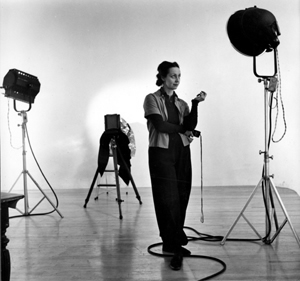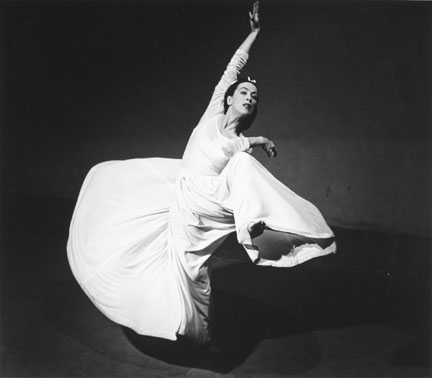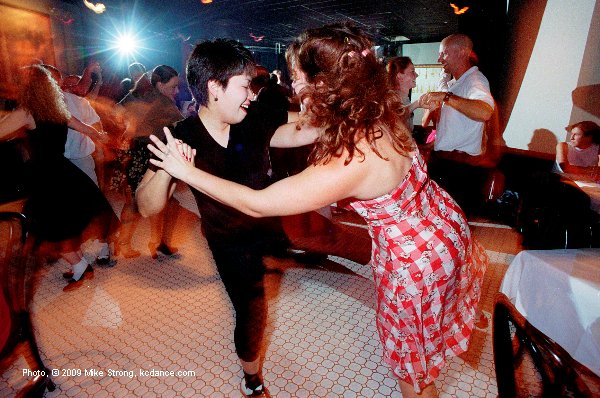Dance Photographer
Barbara Morgan
1900-1992
Some of the most famous dance images originated in the studio of Barbara Morgan as an eyeball to eyeball interaction between Morgan and dancers. Morgan remains one of the most influencial dance photographers ever.
Barbara Morgan in her studio 1942 - experimenting with Lighting (by Willard Morgan)This is where Morgan shot her famous photos. She had specially built space and lighting. She was an early adapter of the electronic flash (speed light) when it became available (about 1939 or 1940). She did not shoot performance. She watched rehearsals, talked to the dancers and choreographers to understand their intent and spent time deciding what parts of the dance she wanted to bring into her studio, not to recreate it as such, but to create again the concept and emotion from those dances in a space and composition purely for camera in a photographic studio.
A major reason for this was lack of control over lighting and time and space. You could not produce photographs of dance with acceptable technical quality consistently at that time, especially with the very much less-sensitive films of that time, and the lack of enough light on stage for cameras. Even today, with ISOs of 1600 or more this is difficult because photographic lighting is usually last in the thoughts of lighting designers, or the schedules of rehearsal directors. Morgan, rightly, moved the dancers to her studio where she could be first in the food chain.
Martha Graham: Letter to the World ("Swirl"), 1940
Although the one below is more famous, this is my favorite from that session, perhaps because her face and thrust to toward us.
Martha Graham: Letter to the World - ("The Kick"), 1940This picture (and the one above) was shot with a 4x5 Speed Graphic at 1/600th second. Four assistants stood around the studio, each positioning a light, pointing it at Graham. From the interview (American Photographer, 1982) it is unclear whether the lights were light bulbs or speed lights with a shutter set at 1/600th second. Morgan was an early adaptor of speed lights (electronic flash) but she was used to and relied on sychronized multiple flash with flash bulbs. In either case, the 600th of a second exposure "stopped" the motion of Graham's dress. Martha repeated this single kicking sequence again and again until Morgan was sure she had the image.
From the 1982 American Photographer interview
“To capture the emotion of the movement, Morgan says she had to ‘free the figure within the space’ by giving the picture a flowing, unanchored background that would serve to sharpen the image of the dancer. To achieve this effect, she remembers stationing four assistants around the set, outfitting each with a single lamp to be trained on the dancer. With the lights wired to a single circuit, she then activated them simultaneously, popping each for approximately 1/600th of a second, effectively equaling the time of her shutter speed as well as the rapidity of Graham’s movement. The technique produced the desired likeness of a blurry studio floor and backdrop, lending further prominence to the figure of the dancer.
What isn't really spelled out in the interview above are Morgan's exact technical specs. The interviewer either assumed facts given elsewhere or failed to realize that she may also have been describing multiple flash heads with tungsten-filiament bulbs and a fast shutter speed, or just assumed. However, Barbara Morgan appears to be describing electronic flash
No flash bulb (see below) produces a flash of only 1/600th of a second. Flash bulbs take much longer, to ramp up to maximum brightness before the shutter opens, and after the shutter closed, to dim back down. This is, however, a common enough duration time for a flash tube (electronic flash). So I am guessing that this picture was shot with electronic flash, which in 1940, was new on the market and very expensive and bulky compared to today.
The desire to produce a blurry studio floor and backdrop while the dancer is sharp would further indicate electronic flash in which the 1/600th of a second exposure would come from the flash tubes and the the shutter would be open a good deal longer to allow ambient light to come in both before and after the electronic flash. So the ambient light would produce exposure on the floor and background which would be a bit blurred because of camera motion and/or depth of field while the overwhelming light from the electronic flash tube would dominiate in the area they are aimed at, the dancer, Martha Graham.
Example of electronic flash ("speed light" exposure of 1,000th second or more) plus ambient light caught with much longer shutter speed.
Photo Mike Strong - Raoul's Velvet Lounge in Overland Park - Swing dancers, music by Dave StephensIn the shot above there are really two exposures, one on top of another, during a single opening of the shutter.
1 - The shutter is open for a longer time (probably about 15th or 8th of a second) which gets an exposure from the existing light in the room producing motion blur in figures, etc. behind our principals.
2 - The electronic flash is triggered at the end of the exposure, just before the shutter closes. This flash, on the camera, in turn triggers a set of other electronic flashes posted around the room, which have "slave" triggers, looking for another flash in order to set off the unit they are connected to. This gives us the backlight and hair light. The light on the camera gives us the main exposure with the "stopped" motion in the foregroudn dancers.
Notice how the definition of the dancers in the front helps to separate them from the blur in the background.
In this example of "speed light" plus ambient the technical reasons are similar to but also different from Morgan's.
To start, this is on location, in a nightclub. The film has probably at least twice or more the sensitivity of films available to Morgan. The electronic flash units are tiny and battery powered compared to the large, mains powered units she would have used. The actuall speed for the small flashe used in the swing picture are unknown, as these are automatic flashes and the amount of time they are on varies while Morgan would set the period of on/off time.
Just as Morgan's pictures made use of technical developments not available to photographers decades prior to her, so too, the picture above of swing dancers at Raoul's Velvet lounge uses extremely portable equipment and highly sensitive film not available in the 30's and 40's.
The thought behind what kind of shots to make was worked out over a long period of time through direct dancing experience on the social dance floor with other social dancers rather than through a concious and purposeful collaboration with choreographer and dancers and photographer. But it was also based on knowledge gleaned before the shoot rather than just coming in to the location and shooting any old action.
Quoting a footnote (emphasis added, then expanded on below):
In a 1953 article in Aperture , No. 4: p. 21, “Kinetic Design in Photography,” Morgan comments on the production of her action photographs. “The 4x5 Speed Graphic and Leica are my cameras for action work. Pressed to cheekbone and eye socket, they are a part of me with minimum lag in shooting. The 1/1000 second shutter speed serves most needs. The Speed Graphic is my choice when the pictures are to be built with light as are the dance photographs for my book, Martha Graham and other work in that field. To create the dramatic lighting in keeping with the subject I use synchro-flash lighting, sometimes with flood light accompaniment. Only the most frenzied movement is shot with speed–light, for I scrupulously gauge shutter time to movement time except in special exceptions. To over-shoot a movement is to make it another movement.” In a hand written note aside this quote, Morgan added: “Not entirely accurate—I vary the speed for differences of 1/50, 1/100, 1/200, 1/500, 1/600, 1/800, 1/1000, 1/10,000 sec. According to the emotion and movement.” A note in Morgan's handwriting found in the personal copy given to Curtis L. Carter, of the catalogue by Leonard N. Amico and Stephen Robert Edidin, The Photographs of Barbara Morgan (Williamstown, Massachusetts: Williams College Museum of Art, 1978), beside the above text quoted in this work, p. 15.
Explanation of tech information gleaned from this footnote:
- "To create the dramatic lighting in keeping with the subject I use
synchro-flash lighting"
- This means flash bulbs - using tungsten-filiament elements which burn brightly
- These bulbs take a short time to get to full brightness so
- the shutter has to be synchronized to open slightly after the bulb starts
- This is "M" synch for a between-the-lens shutter
- When you press the shutter button an electric circuit to the flash bulb is closed very shortly before the shutter itself opens.
- The shutter then opens when the bulb is burning at its brightest.
- "sometimes with flood light accompaniment"
- in other words, she also often had continuously on lights to provide extra light to fill out details or background
- "Only the most frenzied movement is shot with speed–light"
- "speed-light" is one of the older terms for electronic flash
- when movement was too rapid for a shutter to stop, she went to the new "speed lights" ("the most frenzied")
- electronic flash (speed light) became available at the end of the 1930's and Morgan was one of the early adaptors
- electronic flash can be used instead of shutter speed because the light turns on and then off so rapidly that the flash is essentially a shutter. You just need to have the shutter open first, and then turn on the electronic flash, and then close the shutter (to avoid getting more exposure from light in the room.
- This is how she can get the speeds of more than 1/1000th of a second,
or in the late 1930's more than a 1/400th of a second for most then-available
between-the-lens shutters
- Side Note: "FP" synch was for focal-plane shutters.
- Focal-plane shutters were just in front of the film plane. They were like window shades (called curtains) which traveled across the film.
- FP shutters could have one curtain which started first and then a following curtain which closed across the film or a single curtain with a traveling slit.
- The type in the Graphics was like a window shade with a traveling open slit for the light to get through.
- Although these exposed each part of the film at say, 1/1000th of a second, they took much longer than 1/1000th of a second to get fully across the film. So curtain shutters were not useful for "stopping" motion because any movement would be distorted across the frame as the slit moved across the movement. These effect was sometimes noted as a graphical effect and the usual illustration showed a moving car stretched in a diagonal direction.
- "... for I scrupulously gauge shutter time to movement time except
in special exceptions."
- she uses a between-the-lens shutter speed which will give her just enough speed to "stop" movement to the degree required.
- This usually means at least a 200th of a second or more.

Erick Hawkins, "Ell Penitente"

"Celebration" Choreograph by Martha Graham

Doris Humphrey

Graham Group, "American Document," Sophie Maslow, Frieda Flier and
Marjorie Mazia - (Starburst), 1938
I am still struck by "Starburst" everytime I look at the picture. This is also a good example of framing to include only the picture. This is my version of tight. In this case that means a lot of what is usually refered to as "negative space," a term I don't care for because it implies an exception to the rules. For me, the space around the dancers is the space they inhabit. It is an extension of themselves.
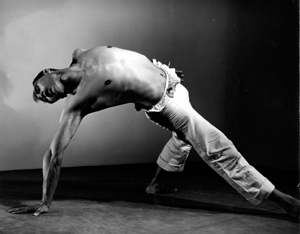
Jose Limon, Mexican Suite, 1944
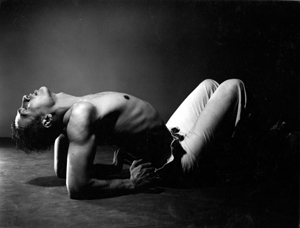
Jose Limon, Mexican Suite, 1944
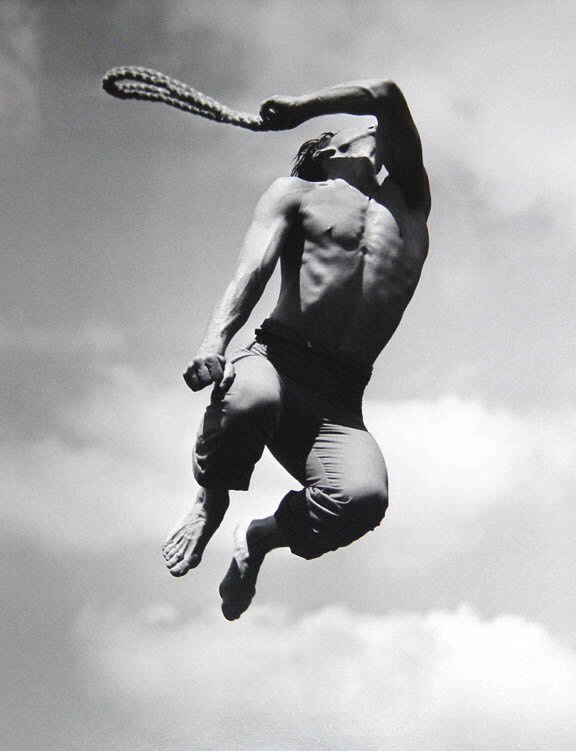
Martha Graham's "El Penitente," Flagellante - Dancer: Erick Hawkins,
1940

Pearl Primus, Speak to me of Rivers, 1944

Doris Humphrey, "Square Dance," (Duet with Charles Weidman, 1938
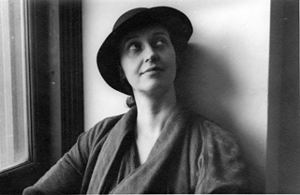
Barbara Morgan
Reference Links
http://marquette.edu/haggerty/exhibitions/past/morgan2004.html
- FACES OF MODERN DANCE
BARBARA MORGAN PHOTOGRAPHS, June 3 - August 15, 2004, Patrick and Beatrice
Haggerty Museum of Art, Marquette University, Milwaukee, Wisconsin, "
Barbara Morgan, Photographer of Modern Dance" by Curtis L. Carter http://www.marquette.edu/haggerty/exhibitions/past/morgan.pdf
http://www.mocp.org/collections/permanent/morgan_barbara.php - Museum of Contemporary Photography
